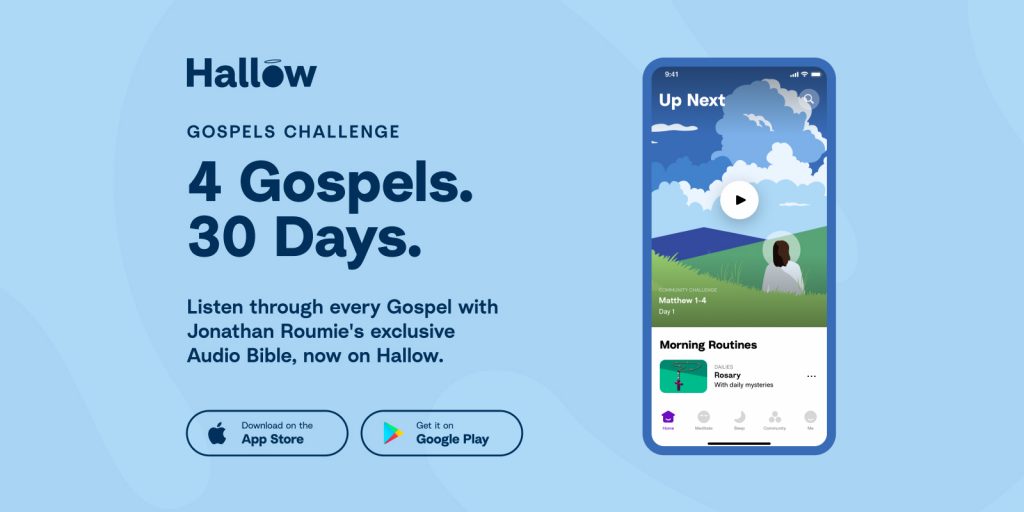The Gospels are the first four books of the New Testament: Matthew, Mark, Luke, and John. These four books detail the life of Christ. Praying with the Good News leads us to better know and love Christ through the testament of his life on earth.
What are the Gospels?
General origin
The Gospels are the first four books of the New Testament. Sharing stories about the life of Christ, these books teach us facts about Jesus’ life and the lessons we should learn from these true stories. Scholars continue to research the dates, authors, and editors associated with these Biblical accounts.
Authorship wasn’t the same in the first century as it is now. Nowadays, an author typically types their piece, edits it, and sends it to their editor. Back then, an author might have dictated the piece to a scribe or even left it up to a student or pupil to work on a section. Sharing texts with others was no easy task, either. Back in the first century (and up to the invention of the printing press), all texts were copied by hand.
Guided by the Holy Spirit
Intuitively, we know the text probably wasn’t copied exactly as it was originally shared. Although no one knows for certain when the Gospels were written or who might have been part of the writing process, what’s most important is remembering their guide — the Holy Spirit. The Holy Spirit guided the composition of the four Gospels, and each time we pray with the Gospels, the Holy Spirit is with us, too.
I have said these things to you while I am still with you. But the Advocate, the Holy Spirit, whom the Father will send in my name, will teach you everything, and remind you of all that I have said to you.
John 14:25-26
The four Gospels are not all the same — which stories they include, the writing process behind them, and their intended audiences. However, these differences actually give us a fuller knowledge and understanding of the life of Christ. We know more stories about His life, and each author leads us to discover different lessons in their respective texts.
Synoptic Gospels
Of the four books, Matthew, Mark, and Luke are most similar to one another. They share similar content, structure and often use the same wording. Because of this, scholars refer to these first three books of the New Testament as the “synoptic” Gospels. “Synoptic” comes from the Greek word “synoptikos,” meaning to take a comprehensive view. Some scholars believe the three authors shared a similar source, while others believe one Gospel served as a source for the other two. This dispute is called the “synoptic problem.” Regardless, the synoptic Gospels are beautifully written, and each author had their own way of addressing a different audience.
The Gospel of Matthew
Although there is some debate, tradition holds that the Gospel of Matthew was written by St. Matthew, tax-collector turned disciple of Jesus. Matthew intended that his Gospel appeal to then-current Jews at the time of his writing. For centuries, Jews prayed for a messiah to deliver them. So, Matthew sought to tell them the good news — Jesus was the one they waited for all these years. Thus, Matthew begins his Gospel with the following: “An account of the genealogy of Jesus the Messiah, the son of David, the son of Abraham” (Matthew 1:1). An angel represents Matthew when he is depicted in art.
The Gospel of Mark
Tradition holds that Mark was a companion of both Paul and Peter. Mark’s Gospel focuses on the action and leadership of Christ, appealing to the Romans at the time of his authorship. This Gospel actually skips over Jesus’ birth and childhood and jumps directly into his public ministry. Mark starts his Gospel by recounting the words of the prophet Isaiah and John the Baptist. He announces the arrival of Jesus, the Messenger of God: “He proclaimed, “The one who is more powerful than I is coming after me; I am not worthy to stoop down and untie the thong of his sandals. I have baptized you with water; but he will baptize you with the Holy Spirit” (Mark 1:7-8). In religious art, a lion represents Mark.
The Gospel of Luke
Luke was believed to have written his eloquent Gospel for the general Greco-Roman world, not necessarily for people of the Jewish tradition at the time. A Gentile himself, tradition holds that Luke was a physician and companion of the Apostle Paul. He addresses the book to “Theophilus,” which translates to ‘friend of God’ or ‘loved by God.’ Luke likely wrote this testimony on the life of Christ to make the Christian faith approachable.
Arguably the best storyteller among the four evangelists, Luke’s Gospel focuses on the humanity of Christ during his time on earth. In the first chapter, Luke focuses on telling the truth to Theophilus. “I too decided, after investigating everything carefully from the very first, to write an orderly account for you, most excellent Theophilus, so that you may know the truth concerning the things about which you have been instructed” Luke 1:3-4). In art, an ox represents Luke.
The fourth Gospel: John
The fourth and final Gospel is attributed to John, the Beloved Disciple. The theology of John’s Gospel is rich with symbols and metaphors for us to better love and know Christ. While John’s Gospel omits much of the stories and parables from Christ’s life included by the Synoptics, it adds a new dimension to our understanding of the life of Christ. John emphasizes Christ as the Logos or “Word,” the divine reason for Creation. John begins his Gospel with this truth. “In the beginning was the Word, and the Word was with God, and the Word was God. He was in the beginning with God. All things came into being through him, and without him, not one thing came into being” (John 1:1-3). An eagle represents John in art.
Have you ever wanted to hear Jesus read you the Bible?
Well, now you can hear all four Gospels narrated by Jonathan Roumie, the actor who plays Jesus in the viral crowdfunded streaming series, The Chosen, exclusively on the Hallow App. As part of the 30-Day Gospel Challenge, Jonathan reads a few chapters of each Gospel every day for 30 days.
Why do we read the Gospels?
The Life of Christ
As humans, we connect with others by telling stories and listening to them. And, we’ve been connecting like this since the beginning of time! God created us knowing this. It’s why we see stories in Creation all around us, and why He sent His only Son to earth — to connect with us and therefore lead us to Him. The Word, and the Gospels, are no different. The Holy Spirit guided the composition of these four books — for you, for me, for everyone — to hear the true stories of Christ’s life. We read, listen to, and meditate upon these stories so that we might become closer to God. We also see that Christ fulfilled the promises God made in the Old Testament — giving us new life.
When do we pray with the Gospels?
In Mass
The Church’s Liturgy is based on a three-year calendar for Sunday Masses and a two-year calendar for daily Mass. As a result, each time you attend Mass and celebrate the Liturgy, you hear a reading from the Gospel. This organization of Scripture is called the Lectionary. In the Lectionary, the Church divides three years into three liturgical years: A, B, and C. The Gospel of Matthew makes up most of Year A, Mark for Year B, and Luke for Year C. The Gospel of John is read during the Easter season, no matter the current liturgical year.
If you go to Mass every Sunday for three years, you’ll hear most of the four Gospels. While not every single verse is included in the Lectionary, the Church thought long and hard about making sure we hear the full story of Christ’s life.
Daily conversation with God
You can pray with the Gospel every day! There are several ways to pray with the Gospels outside of Mass. First, the Gospels are always available to you as a source of prayer inspiration, Bible study, imaginative prayer, or Lectio Divina. Secondly, you can pray with the Daily Gospel (taken from the Daily Bible Reading) in your daily conversation with God at any time of the day on the Hallow App.
How to Pray: The Gospels
First, choose a passage
Select a passage from Matthew, Mark, Luke, or John. You could use the Daily Bible Reading based on the Lectionary, or you could pray with one of your favorite parables or moments in Christ’s life. We recommend starting with something shorter. You might want to consider these 8 stories from Christ’s life:
- Jesus and the Leper (Mark 1:40-45)
- The Boy Jesus in the Temple (Luke 2:41-52)
- Jesus Feed the Five Thousand (Matthew 14:13-21)
- A Man Born Blind Receives Sight (John 9)
- The Parable of the Good Samaritan (Luke 10:25-37)
- Jesus and the Woman at the Well (John 4)
- The Beatitudes (Matthew 5:13-21)
- The Wedding at Cana (John 2:1-11)
- Jesus Walks on the Water (Matthew 14:22-33)
Second, picture yourself in the moment.
Read (or listen to) the passage you select a few times and begin to imagine yourself there, besides Christ and among his disciples. This method of prayer is a type of Ignatian contemplation. Ask yourself a few questions to set the scene as you let the Holy Spirit begin to move through your time in prayer.
- What does the scene look like?
- Who are you in the scene?
- Are you in nature — besides the water or atop a mountain?
- Are you searching for something?
Third, acknowledge what stands out to you.
Now that you imagine yourself in the scene, you can begin to notice what stands out to you. This might be something visual, or it might be something more intangible. What is the Holy Spirit leading you to as you read or listen to Scripture? Take a few moments to rest with what you notice. Is it something Jesus says in Scripture? Is it the beauty of the nature you imagine yourself being surrounded by? Let your prayer focus on this word, sense, or image at the forefront of your mind. Again, anything that sticks out is worthy of your prayer — this is the Holy Spirit leading you.
Lastly, rest with Christ.
Remember, praying with the Gospels is meant to lead us closer to Jesus. As we meditate on the Word, we understand the depth of Christ’s thirty-three years on earth. We celebrate the coming of the Messiah (Matthew), appreciate his servant leadership (Mark), relate to his humanity (Luke), and sit in awe of how he is the divine purpose of Creation (John).
We are so excited to release Hallow’s exclusive audio-guided Gospels, read by Jonathan Roumie! We’re kicking off this release by listening to all four Gospels in 30 days for the new 30-Day Gospel Challenge in Hallow. We look forward to journeying with Jesus as we pray through Matthew, Mark, Luke, and John.



